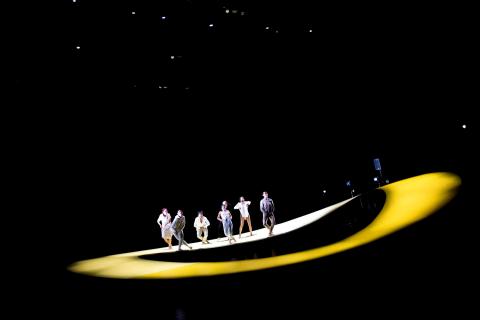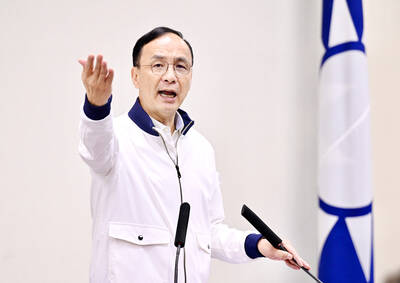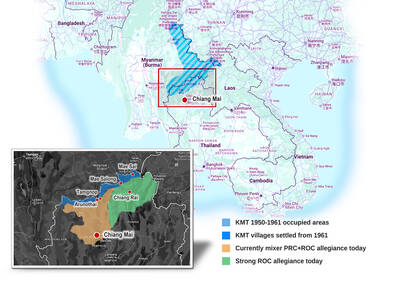Pichet Klunchun, whose company will be at the Cloud Gate Theater next weekend, began training in Thailand’s classical Khon mask dance when he was 16, going on to earn a bachelor’s degree in Thai classical dance from Chulalongkorn University, the Thai equivalent of National Taiwan University.
He started training at 16, late for a Khon dancer, after a chance meeting with a renowned Khon master, Chaiyot Khummanee. He said studying Khon helped him deal with his loneliness after moving to Bangkok, and later helped him to define himself — the long hours of repeating basic motions gave him time to think about life.
However, it was a stay in New York City when he was 30, thanks to an Asian Cultural Council fellowship in 2002, that changed his life forever. It opened his eyes up to modern dance world and strengthened his determination to deconstruct Khon and infuse it with contemporary movement — an idea that has meant his works are more widely appreciated and in demand outside of Thailand than at home.

Photo Courtesy of Pichet Kluchun Dance Company
For example, Dancing with Death (靈薄域), the work the Pichet Kluchen Dance Company will perform in Tamsui next weekend, was commissioned by Singapore’s Esplanade – Theatres on the Bay for its da:ns series festival last year, with cosponsorship from festivals in Yokohama, Japan, and Melbourne and Adelaide, Australia. At home, he has admitted in interviews, he struggles to get audiences into the theater he built — and keep them there.
However, Klunchun’s early works drew the attention of Cloud Gate Dance Theatre (雲門舞集) founder and artistic director Lin Hwai-min (林懷民), who twice invited him to take part in the Novel Hall Dance Series that Lin curated for the now sorely missed Novel Hall theater.
Lin saw Pichet and French choreographer Jerome Bel in a piece that was then called Made in Thailand at a festival in France and invited them to bring the piece to Taipei in 2006, by which time it had been retitled Pichet Klunchun and Myself. Pichet returned on his own the following year for the Novel Hall series themed “Men Dancing,” bringing his I am a demon, an exploration of the four character types in Khon theater.
Pichet counts Lin among his mentors and the two men certainly appear to have much in common, despite the difference in age, culture and training. Like Lin’s company, Pichet’s troupe, established in 2004, is the first professional company in Thailand where dancing is a full-time job, and, like Lin, Pichet creates works that combine his nation’s traditional art forms and motifs with modern dance, contemporizing classical culture.
‘Questioning Culture’
In interviews, Pichet has spoken about the need to keep traditional culture alive so young people can know about their past, but he also insists that culture must be free to be questioned, challenged, changed or even destroyed.
“Questioning means people are curious about culture” and that is a good thing, he said.
That goes to the heart of one of Pichet’s struggles: getting audiences involved and invested in performances. Traditionally, Khon dance has been seen as such a high art form in Thailand that it was not questioned, it was only to be watched, not commented on, he has said.
In one interview he said he feels like he has succeeded even if people are angry enough to walk out of his performances, because it demonstrates that they are questioning what they see.
It is unlikely that anyone is going to walk out of Dancing with Death, which is set on seven dancers, including Pichet.
Inspired by the traditional “Phi Ta Khon” carnival in northeastern Thailand where people wear colorful masks and costumes to honor fertility and death, Pichet explores the Buddhist philosophy that death is but part of the cycle of life, not the end of a life, but the rebirth of a soul, something to be celebrated, not mourned.
The circle that is life is emphasized by the set, a raised, swooping loop that Pichet designed.
“I want to show that death is beautiful,” he said in a short video made to promote the show in Singapore last year. “The aesthetics of this performance are inspired by the freedom found at the heart of folk culture.”
“It allows more ways for me to deconstruct my classical art form,” he said. “And it frees me.”

President William Lai (賴清德) yesterday delivered an address marking the first anniversary of his presidency. In the speech, Lai affirmed Taiwan’s global role in technology, trade and security. He announced economic and national security initiatives, and emphasized democratic values and cross-party cooperation. The following is the full text of his speech: Yesterday, outside of Beida Elementary School in New Taipei City’s Sanxia District (三峽), there was a major traffic accident that, sadly, claimed several lives and resulted in multiple injuries. The Executive Yuan immediately formed a task force, and last night I personally visited the victims in hospital. Central government agencies and the

Australia’s ABC last week published a piece on the recall campaign. The article emphasized the divisions in Taiwanese society and blamed the recall for worsening them. It quotes a supporter of the Taiwan People’s Party (TPP) as saying “I’m 43 years old, born and raised here, and I’ve never seen the country this divided in my entire life.” Apparently, as an adult, she slept through the post-election violence in 2000 and 2004 by the Chinese Nationalist Party (KMT), the veiled coup threats by the military when Chen Shui-bian (陳水扁) became president, the 2006 Red Shirt protests against him ginned up by

As with most of northern Thailand’s Chinese Nationalist Party (KMT) settlements, the village of Arunothai was only given a Thai name once the Thai government began in the 1970s to assert control over the border region and initiate a decades-long process of political integration. The village’s original name, bestowed by its Yunnanese founders when they first settled the valley in the late 1960s, was a Chinese name, Dagudi (大谷地), which literally translates as “a place for threshing rice.” At that time, these village founders did not know how permanent their settlement would be. Most of Arunothai’s first generation were soldiers

Among Thailand’s Chinese Nationalist Party (KMT) villages, a certain rivalry exists between Arunothai, the largest of these villages, and Mae Salong, which is currently the most prosperous. Historically, the rivalry stems from a split in KMT military factions in the early 1960s, which divided command and opium territories after Chiang Kai-shek (蔣介石) cut off open support in 1961 due to international pressure (see part two, “The KMT opium lords of the Golden Triangle,” on May 20). But today this rivalry manifests as a different kind of split, with Arunothai leading a pro-China faction and Mae Salong staunchly aligned to Taiwan.